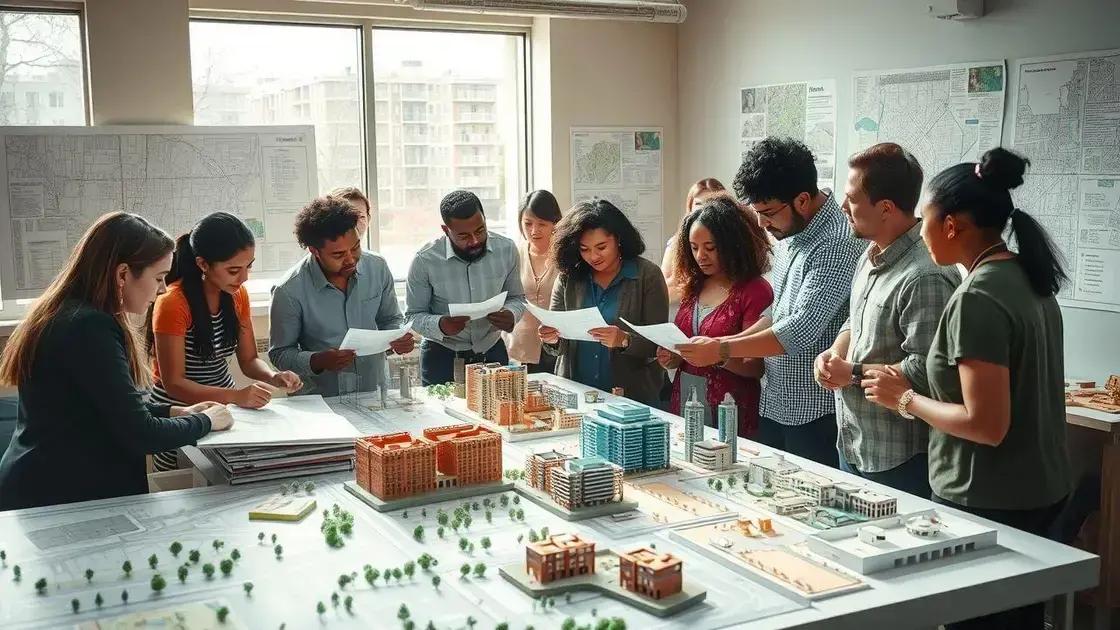City planning: innovative strategies for modern living

Community involvement in urban development fosters inclusivity and ensures that city planning accurately meets the diverse needs of residents through various engagement methods, including technology and public participation.
City planning plays a vital role in shaping our urban environment. Have you ever wondered how cities evolve to meet the needs of their residents? Let’s dive into the core concepts and explore innovative strategies that influence modern urban living.
Understanding the fundamentals of city planning
Understanding the fundamentals of city planning is essential for creating functional urban spaces. City planners work to design areas that meet the needs of the population while considering future growth. This discipline combines various elements including environment, society, and economy to shape vibrant communities.
The role of city planners
City planners analyze the needs of their communities. They work with local governments and organizations to build better neighborhoods. Their goal is to enhance the quality of life for residents. Some key responsibilities include:
- Conducting community assessments
- Developing land-use plans
- Implementing zoning regulations
- Coordinating public transportation systems
Successful city planning relies on collaboration among various stakeholders. Planners must consider the input of residents, businesses, and environmental experts. This collaboration helps ensure that development meets local needs.
Key principles of urban design
Effective urban design is built on several core principles: accessibility, sustainability, and aesthetics. Making cities accessible means ensuring that everyone can navigate the spaces effectively. Sustainable practices minimize environmental impact, preserving resources for future generations. Aesthetic considerations focus on beauty and functionality, creating appealing living environments.
Another significant aspect is community engagement. Engaging residents in the planning process fosters a sense of ownership. It encourages feedback, which provides planners with invaluable insights. This collaborative approach promotes transparency and builds trust within the community.
Adapting to social and technological changes is another fundamental. With rising populations and advances in technology, planners must embrace innovation. Smart technologies can improve city services and infrastructure, making urban areas more efficient and responsive.
City planning is not just about the present; it is also about envisioning the future. By understanding these fundamentals, we can create sustainable, vibrant cities that thrive for generations to come.
Key principles of sustainable urban design

Key principles of sustainable urban design focus on creating cities that are not only functional but also environmentally friendly. These principles aim to reduce ecological footprints while enhancing the quality of life for urban residents. Understanding these concepts is crucial for effective city planning.
Integrating green spaces
One principle involves integrating green spaces into urban layouts. Parks, gardens, and green roofs provide many benefits. They improve air quality, reduce heat, and enhance biodiversity. Incorporating nature in cities helps promote mental well-being and encourages outdoor activity.
- Benefits of green spaces include reduced urban heat effects.
- Enhancement of local wildlife habitats.
- Improved mental health for residents.
- Increased community interaction and engagement.
Another essential principle is the use of sustainable materials. Choosing eco-friendly building materials can significantly decrease a city’s environmental impact. For example, materials that promote energy efficiency minimize waste and conserve resources.
Encouraging public transport
Additionally, promoting public transportation plays a crucial role in sustainable urban design. Efficient transport systems reduce road congestion and pollution. They also provide accessible alternatives to car travel, which helps lower carbon emissions.
Many cities are prioritizing biking and walking paths. These infrastructure improvements encourage residents to choose active transportation options. Cities that balance vehicle use with pedestrian access create healthier environments.
Ultimately, incorporating the principles of sustainable urban design involves collaboration with communities. It requires active participation from residents in the planning process. This inclusion helps ensure that the needs and desires of the public are met while promoting sustainability.
How technology is shaping modern city planning
How technology is shaping modern city planning is an exciting topic that impacts our daily lives. From smart tools to data-driven decisions, technology plays a vital role in creating efficient urban spaces. Innovative solutions are transforming the way we design and manage our cities.
Smart city technologies
Smart cities utilize technology to enhance urban services. Sensors and IoT devices collect data to improve traffic flow, waste management, and public safety. These technologies help city planners gain valuable insights that facilitate better decision-making.
- Traffic management systems reduce congestion.
- Smart lighting improves energy efficiency.
- Connected public transportation enhances accessibility.
- Environmental sensors monitor air quality.
Another essential aspect is the use of geographic information systems (GIS). GIS helps visualize spatial data and analyze trends. Through mapping tools, planners can identify areas needing development or improvement. This technology also aids in planning green spaces and infrastructure projects.
The role of data analytics
Data analytics is crucial in understanding urban dynamics. By analyzing patterns in population growth, housing, and transportation, cities can forecast future needs. This proactive approach allows for more efficient resource allocation.
Moreover, community engagement tools are evolving. Virtual platforms enable residents to participate in the planning process. Feedback from the community can guide city planners in creating spaces that truly serve the public interest. Engaging citizens ensures that developments reflect their needs and desires.
In addition, technology improves collaboration among various stakeholders. When city planners, developers, and residents connect seamlessly through digital platforms, projects move forward more smoothly. Efficient communication fuels innovation and creativity in urban design.
Community involvement in urban development

Community involvement in urban development is essential for creating spaces that reflect the needs and desires of residents. Engaging the community in the planning process helps ensure that developments promote social cohesion and enhance quality of life. By involving citizens, planners can tap into local knowledge and cultural insights.
Importance of public participation
Public participation offers many benefits. It fosters transparency and trust between local authorities and residents. When the community feels heard, they are more likely to support new projects. Moreover, participation can lead to innovative ideas that planners may not have considered.
- Public meetings facilitate open discussions and feedback.
- Online platforms provide convenient ways for people to share their views.
- Surveys can gather diverse opinions on proposed developments.
- Workshops allow for brainstorming and co-creation of solutions.
By embracing diverse voices, urban planners can develop more inclusive solutions. Understanding the unique needs of different demographic groups can improve outcomes for everyone. For instance, considering the perspectives of youth, seniors, and marginalized communities ensures no one is left behind.
Effective community engagement strategies
Effective community engagement involves various strategies. One approach is utilizing technology to reach a broader audience. Social media and dedicated websites allow residents to participate in discussions and stay informed about city projects.
Additionally, traditional outreach methods still hold value. Flyers and in-person events can engage those who may not use digital platforms. Providing platforms for feedback during community meetings cultivates a sense of belonging.
Building long-term relationships with community members is vital. Regular communication keeps residents involved between major projects. This ongoing dialogue reinforces the idea that their opinions matter, fostering a positive relationship with urban planners.
In conclusion, community involvement is crucial for successful urban development. When residents engage with city planners, they shape spaces that reflect local needs. By using technology and traditional methods, cities can gather diverse opinions. This collaboration fosters trust and leads to innovative solutions. Ultimately, inclusive planning helps create vibrant, sustainable urban environments that benefit everyone.
FAQ – Community Involvement in Urban Development
Why is community involvement important in city planning?
Community involvement ensures that urban developments meet the needs and desires of residents, leading to more effective and inclusive solutions.
What methods can be used to engage the community?
Engagement methods include public meetings, online surveys, social media discussions, and workshops to gather diverse opinions.
How does technology enhance community participation?
Technology facilitates easier communication and feedback collection, allowing more residents to participate and share their views.
What are the benefits of involving diverse perspectives?
Incorporating diverse perspectives leads to innovative ideas and ensures that the needs of all demographic groups are considered in urban planning.






